Want to experience two of the best national parks in one epic trip? This 5-day itinerary takes you from Glacier National Park to Yellowstone, with two adventure-filled days in each park. This guide details the highlights, plus important things to know.

Two of America’s most iconic national parks are located about 400 very scenic miles apart. From the stunning glacial lakes of Glacier National Park to the geothermal wonders in Yellowstone, these are two parks on many traveler’s national park bucket lists.
In this guide, we share how to get from Glacier National Park to Yellowstone, plus a 5-day itinerary that gives you two days to explore each park.
Glacier National Park to Yellowstone Itinerary Guide
For more tips and advice for planning your Glacier National Park to Yellowstone itinerary, jump to the following sections (or just keep scrolling to see it all!).
- About Glacier & Yellowstone
- Itinerary overview
- When to go
- Know before you go
- Day 1: Glacier National Park
- Day 2: Glacier National Park
- Day 3: Driving
- Day 4: Yellowstone National Park
- Day 5: Yellowstone National Park
- What to pack

Whether you simply aspire to the visit the parks in your neck of the woods or want to hit them all, be sure to download our FREE national park checklist by clicking below to keep track of your progress!


About Glacier and Yellowstone National Parks
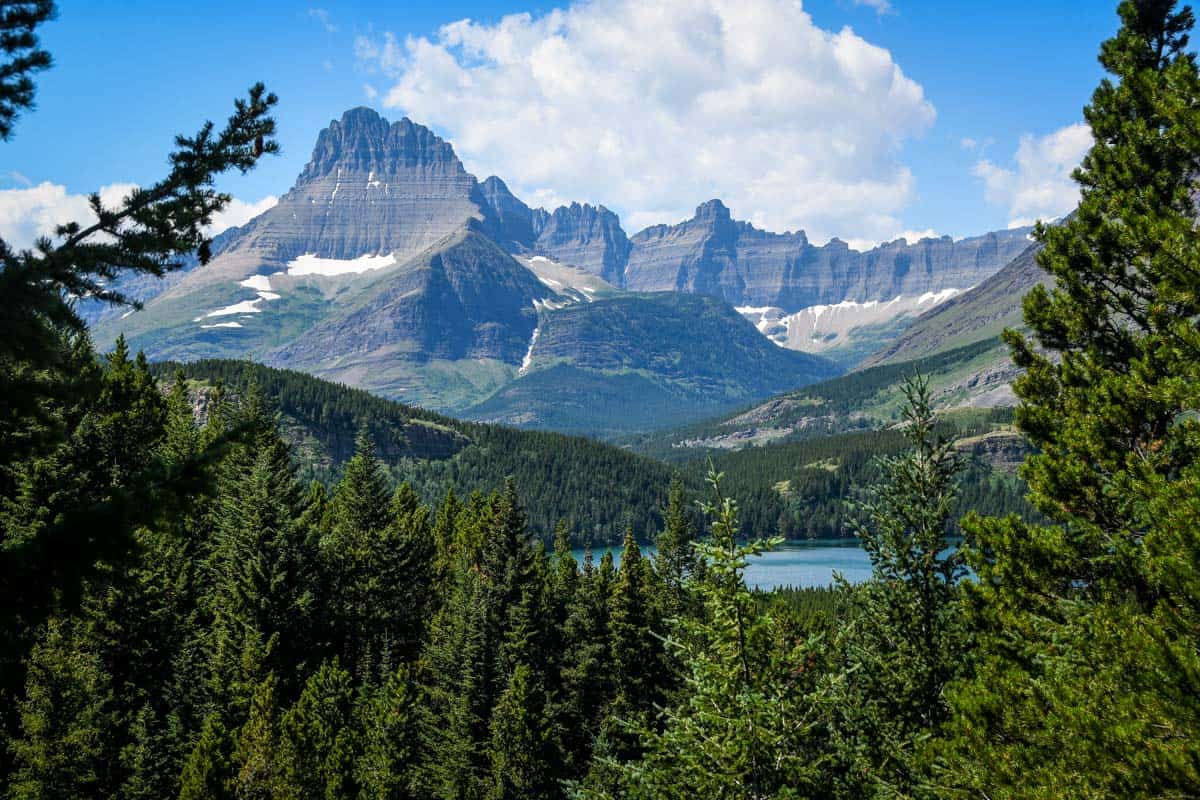
Glacier National Park is in far northwestern Montana on the US-Canada border. Often called the “Jewel of the Continent,” this spectacular park is home to over 35 glaciers, milky blue lakes, wildlife galore, and over 700 miles of epic hiking trails.
Established in 1872, Yellowstone was the first national park in the world. It’s home to over half of the world’s geysers and geothermal features, making the park truly one-of-a-kind.
Yellowstone sits primarily in northwest Wyoming, but also crosses over into Idaho and Montana – which is what makes it such an ideal road trip destination from Glacier.
Psst! We have complete guides to both Glacier National Park and Yellowstone National Park on our sister site.
Glacier National Park to Yellowstone Itinerary Overview

- Day 1: Glacier National Park – Apgar Visitors Center, Lake McDonald and Avalanche Lake hike
- Day 2: Glacier National Park – Going-to-the-Sun Road, Wild Goose Island Overlook, St. Mary Lake, Hidden Lake hike
- Day 3: Transportation day – Flathead Lake, Missoula, Butte, Big Sky
- Day 4: Yellowstone National Park – Upper Geyser Basin, Old Faithful, Biscuit Basin, Grand Prismatic Spring
- Day 5: Yellowstone National Park – Grand Canyon of the Yellowstone, Brink of the Lower Falls, Artist Point
Note: If you prefer to start from Yellowstone, simply do the itinerary in reverse and end in Glacier.
How much time do I need in Glacier National Park?

As with most national parks, the more time you have, the more you can explore Glacier’s 1 million-plus acres and hundreds of lakes.
Of course, not everyone can carve nearly a week out of their lives to explore a national park. So while more is better, you can absolutely enjoy a shorter visit to Glacier National Park.
This itinerary shows off the park’s highlights so you can maximize time and still have a few days to check out Yellowstone! If you have more time to spend in Glacier, check out our Glacier itinerary for 3, 4 and 5 days!
How much time do I need in Yellowstone National Park?
Yellowstone is more than twice the size of Glacier, covering over 2 million acres, so the situation is similar where more time is better. However, two days in Yellowstone is certainly enough to get a taste. If you have more time to spend there, check out our 3 day Yellowstone Itinerary for more ideas.
When to go to Glacier and Yellowstone National Parks?

Overall, the best times to visit Glacier and Yellowstone are summer and early fall (June through late September).
Summer is the peak season, when everything is open and accessible and weather is mostly favorable. However, both parks get extremely crowded, and accommodations (including campsites) sell out far in advance.
Spring and fall can be nice, but weather is dicey and major sections of both parks, including roads, are closed between October and May — sometimes into June (or July, in Glacier!).
Having said that, September is a fantastic month in both parks. Summer crowds are gone, it’s a great time for wildlife viewing, the weather is gorgeous, and all the roads in the parks are open until October.
Winter is magical in both parks, but access is limited due to closures and lack of services/facilities. However, if you’re not planning on doing any hiking, Yellowstone is one of the best national parks to visit in winter, especially because you’ll avoid the massive crowds.
Wanna try out vanlife on your Glacier National Park to Yellowstone road trip?

It’s no secret we are obsessed with #vanlife. If you don’t have the time (or interest) in building your own conversion but you still want to give vanlife a test drive, we’ve got you covered!
We put together an entire guide to the best campervan rental companies in the US over on our sister site, including exclusive discounts for our readers!
One company we’d recommend looking into is Escape Campervans. They have 12 different locations across North America and come fully loaded with all the gear you need for an epic road trip. Plus, their rates are fair and affordable.
BONUS: We’ve partnered with Escape to give you a 10% off discount when you use our link!
Things to know before visiting

- Both parks experience major road closures in the winter and spring, allowing visitors to explore very small sections
- Cell phone reception is spotty at best in Glacier, but nearly non-existent in Yellowstone
- Parking lots fill up and crowds form early, so try to get an extra-early start
- Accommodations sell out quickly and far in advance for summer (up to a year!)
- Glacier and Yellowstone are in bear country, so make lots of noise on trails, carry bear spray, and store food properly
- Aside from bears, tons of wildlife call both parks home. Give them plenty of room, and don’t approach or attempt to feed them.
America the Beautiful annual park pass

If you’re planning to visit more than just Glacier and Yellowstone National Parks, we’d highly encourage you to look into getting an annual park pass. At $35+ per vehicle upon entry, visiting the national parks in the U.S. can get expensive.
For just $80 per year, you can purchase the America the Beautiful park pass. This pass grants you free access to all of the national parks. Plus it also covers your entrance to over 2,000 natural, historical, and recreational sites across the United States.
→ If you still need convincing, check out our article: National Park Annual Pass: Is it Worthwhile? + How to Buy

And now with all that info out of the way, let’s get into the fun part!
Day 1 | Glacier National Park
Although Glacier has several entrances, we recommend first-timers start in West Glacier. There are more services and amenities here, plus some of the most popular trails and sites.
Apgar Village & Lake Mcdonald
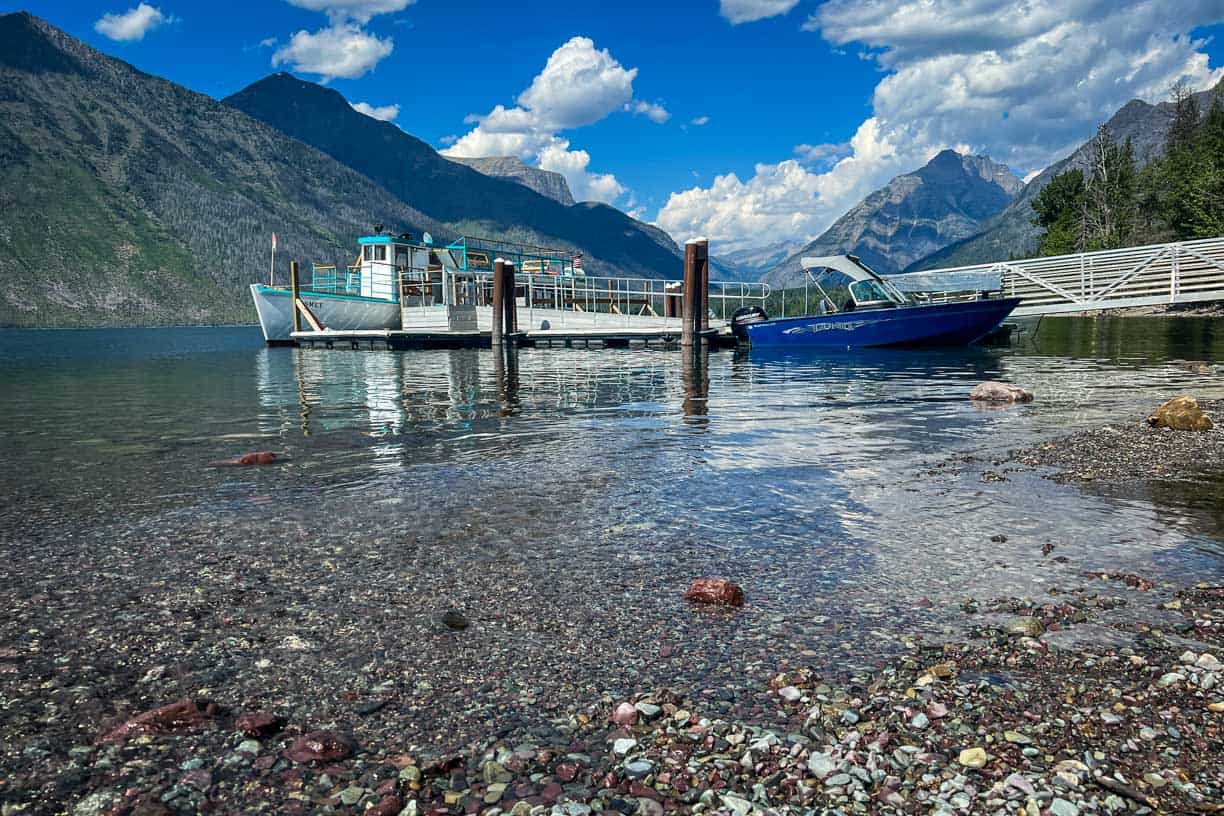
One of Glacier’s best views is also one of its most accessible. Lake McDonald is one of the first stops from the West Glacier entrance and it showcases what the park is all about: larger-than-life snow-capped mountains, sparkling lakes, and breathtaking scenery.
Soak in the views, especially at sunrise or sunset, and get out on the water, too. Rent kayaks or paddle boards, or take a lake cruise during the summer.
Before hitting the road, browse the shops and grab a coffee in Apgar Village.
Hike the Trail of the Cedars to Avalanche Lake

- Distance: 5.9 miles, out and back
- Elevation gain: 757 ft
- Difficulty rating: moderate
- Trail notes on Alltrails
Near Apgar, the Trail of the Cedars is a relatively flat, easy 0.9-mile hike that passes through spectacular scenery. If you’re up for it, complete the full 5.9-mile hike to Avalanche Lake.
Psst! This is one of the best hikes in Glacier National Park. Check out our article to see the rest!
Day 2 | Glacier National Park
Today you’ll drive the iconic Going-to-the-Sun Road. This scenic 50-mile drive packs jaw-dropping views, great opportunities to see wildlife, and access to some amazing hikes.
Going-To-The-Sun Road

Known as the GTTSR, this jaw-dropping road spans 50 miles across the park from Apgar to St. Mary. It crosses the Continental Divide and provides countless “ooh-ahh” moments.
Driving the GTTSR one-way without stopping takes about two hours, but could easily take a full day with stops and hikes along the way. Sections of the road are closed from mid-October through most of June and sometimes into early July, so keep that in mind when deciding when to visit.
Hike to Hidden Lake at Logan Pass

The GTTSR crosses the Continental Divide at Logan Pass and as you’d expect, it’s spectacular. The drive itself is just as spectacular, actually, about one hour from West Glacier.
Once there, hike to Hidden Lake Overlook, just under 3 miles round-trip. The overlook is an easy going hike and if you’d like more of a challenge, head down to the lake.
Hidden Lake Trail
- Distance: 5.1 miles, out and back
- Elevation gain: 1,338 ft
- Difficulty rating: moderate
- Trail notes on Alltrails
Hidden Lake is frequented by grizzly bears and mountain goats, so the trail sometimes closes temporarily beyond the overlook. Also, parking is a major issue at Logan Pass, so plan to stop extremely early or late in the day.
Don’t forget to bring your bear spray for hiking in this park!
Wild Goose Island Overlook

One of the most photographed spots in Glacier, teeny-tiny Wild Goose Island sits in the middle of St. Mary Lake, dwarfed by the mountains. This short and sweet stop near St. Mary, simply stop and enjoy the breathtaking view.
St. Mary
St. Mary is another quick stop. Grab a late lunch or have a picnic before heading back west on Going-to-the-Sun Road. Mountain Bar inside the main lodge is the best place to grab a quick drink (we recommend the huckleberry cocktails!), but you can also sit down for a meal at Snowgoose Grille.
On your way back, stop at any overlooks that strike your fancy and not the difference in views from one direction to the other. Maybe attempt the fairly easy 3.1-mile hike to St. Mary and Virginia Falls. It’s one of the most popular in the park, but you can easily add Baring Falls with a short detour or by starting at Sun Point.
Psst! If you plan on camping over night, check out our complete guide to camping in Glacier National Park.
Day 3 | Road trip

- Distance: 400 miles
- Driving time: 7-8 hours
After two busy days in Glacier, today should be more relaxed. There are several route options for getting from Glacier National Park to Yellowstone, and all are equally fantastic — never-ending views and plenty of interesting stops.
Flathead Lake & Big Fork

Massive Flathead Lake is stunning. Stop to go for a swim or paddle, or simply enjoy the scenery. It’s also popular for trout fishing.
Dozens of breweries and laid-back restaurants and bars dot the lakeshore, and the town of Kalispell is also worth a stop.
Missoula
Missoula is a fantastic city combining big city amenities and Montana ruggedness. It’s fantastic for art or history lovers, with several museums, galleries, and historic areas.
Montana University is also here and downtown is full of wineries, breweries, and quirky boutiques. During the summer, there are frequent farmers’ markets and other outdoor events.
Butte
A historic mining town with deep roots, Butte feels a bit like stepping back in time. The World Museum of Mining is worth a stop, and there are several mine tours in town.
Big Sky

The resort town of Big Sky is about an hour from West Yellowstone. Four-season recreation includes hiking (don’t miss Ousel Falls!), rafting, horseback riding, biking, and winter sports.
Day 4 | Yellowstone National Park
The biggest decision of your Glacier National Park to Yellowstone itinerary is which Yellowstone entrance to visit. Coming from Glacier, it makes the most sense to enter Yellowstone through the North entrance and pass through the historic Roosevelt Arch.
Though you could also reroute to the West entrance and skip Mammoth Hot Springs to head straight for Grand Prismatic Spring first thing.
Tip: Especially in the summer, Yellowstone’s Grand Loop gets extremely crowded and traffic can be frustrating. Bring snacks to hold yourselves over and start as early as possible!
Mammoth Hot Springs
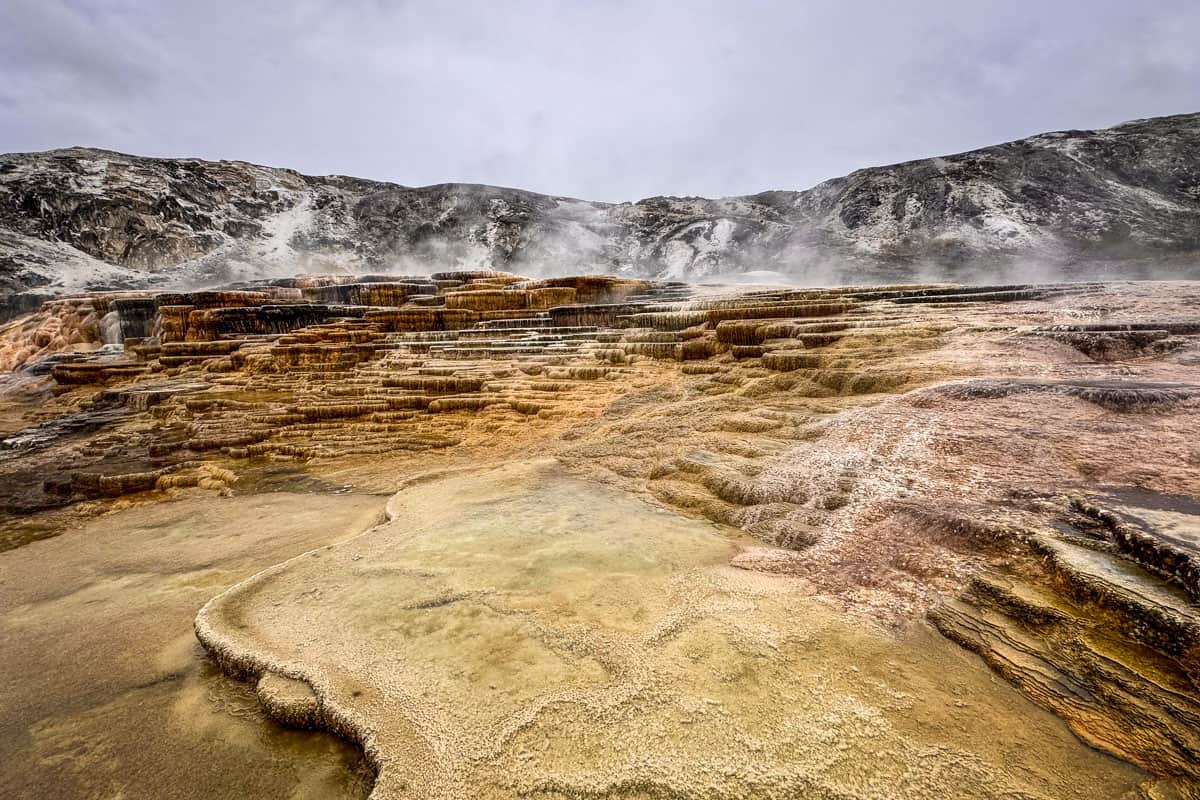
This is a great place to start your day, especially if you catch sunrise from Canary Spring. The viewing platform is at the terraces’ high point, giving you a great vantage point.
Because the iconic travertine terraces are so active, their colors and overall appearance change constantly. They’re always milky, opalescent white, but you may also see neons and pastels. You can visit several times and never have the same experience!
Mammoth Terraces Trail

- Distance: 2.5 miles out-and-back
- Elevation gain: 383 feet elevation gain
- Difficulty rating: Easy
- Trail notes on Alltrails
After enjoying some tranquility and early morning views, take this short, fairly easy hike (budget about 1.5 hours). The trail is a series of boardwalks and paved pathways, but there are also stairs and steep sections.
You’ll pass more than a dozen springs, but some highlights include Opal Terrace, Palette Spring, Liberty Cap, and Canary Spring.
Biscuit Basin
Much quieter Biscuit Basin is just a few minutes drive from Mammoth Hot Springs, home to several colorful pools and geysers. Take a short drive or hike the 2.2-mile (one-way) Artemisia Trail if you’re feeling ambitious.
Walk the 0.6-mile boardwalk and enjoy the bright colors and lack of crowds. You can get significantly closer to geysers in Biscuit Basin, but remember — do not leave the boardwalk!
Grand Prismatic Spring

Continue on your first day in Yellowstone to check out one of the park’s stunners: Grand Prismatic Spring. It’s the third-largest geothermal spring in the world!
The spring’s vibrant colors truly can’t be captured in photos or explained with words; you HAVE to see this place with your own eyes.

You can see Grand Prismatic up close from the boardwalk, and we recommend doing the whole loop around Midway Geyser Basin while you’re there.
For an unbeatable view, we recommend you head to Grand Prismatic Overlook, one of the best hikes in Yellowstone. The easygoing, 1.5-mile roundtrip hike gains 200 feet of elevation and is a perfect way to end the day.
Old Faithful
As one of Yellowstone’s most famous attractions, Old Faithful draws huge crowds trying to get a glimpse of the eruptions, which shoot up to 100 feet high.
Old Faithful erupts on a very predictable schedule, every 60-90 minutes. Interestingly, exactly when depends on the previous eruption — if it was 2.5 minutes or less, the next eruption should be 65 minutes later. 2.5-minute or longer eruptions mean Old Faithful will erupt again at 91 minutes.
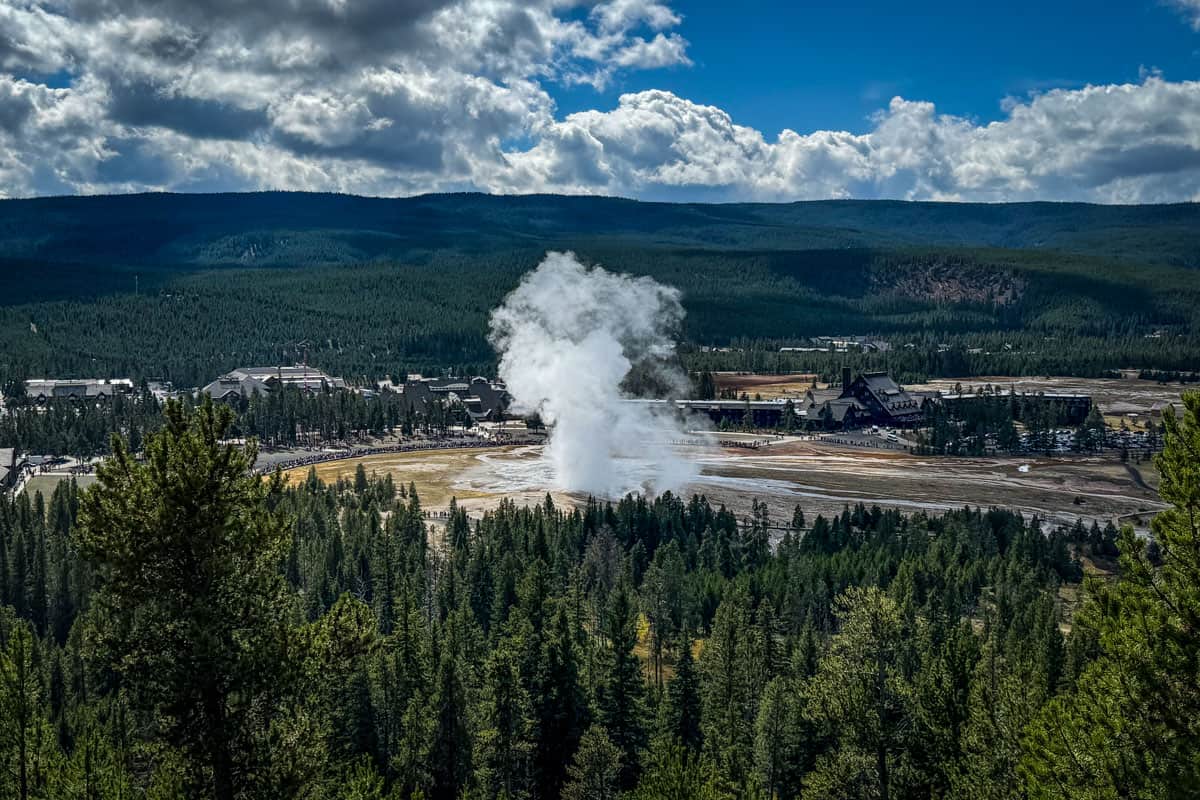
We recommend checking out the eruption from the ground as it’ll be cool to see it up close. However, to avoid some of the crowds and get a different view of Old Faithful, the 1.5-mile (roundtrip) Observation Point hike is a can’t miss!
Upper Geyser Basin

Next, take the easy hike on the boardwalks through the rest of Upper Geyser Basin. This is the world’s highest concentration of geysers and geothermal features (and unsurprisingly, the busiest part of Yellowstone)!
To get there, walk 1.4 miles along the boardwalk from Old Faithful to Morning Glory Pool. You’ll pass colorful, otherworldly geysers, hot springs, and colorful pools.
Day 5 | Yellowstone National Park
The final day of your Glacier National Park to Yellowstone trip includes a few jaw-dropping sites. Again, these areas get extremely crowded early, so get started before the sun if possible.
Although the Grand Canyon of the Yellowstone area is one main site, there’s a lot to do here, with several viewpoints and trails on both the north and south sides of the rim.
You’ll hike along the canyon rim and drive to several spectacular viewpoints, then finish the day wandering through Norris Geyser Basin, one of Yellowstone’s most active.
Grand Canyon of Yellowstone
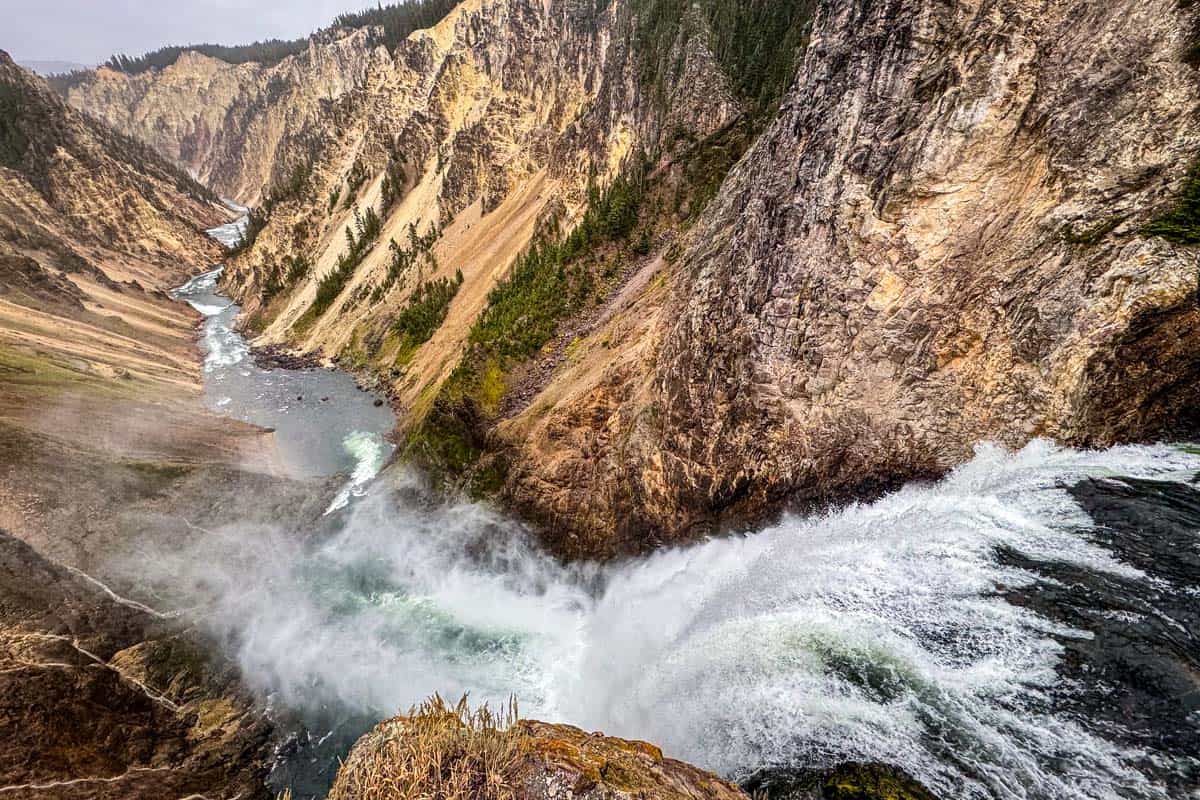
Carved out by the Yellowstone River, this breathtaking geological gem is over 20 miles long and up to 1,200 feet deep.
Fun fact: The canyon’s yellow walls are thought to be the river’s namesake (and later, the park’s).
Point Sublime via Artist Point Trail

- Distance: 2.7 miles, out-and-back
- Elevation gain: 341 ft
- Difficulty rating: moderate
- Trail notes on Alltrails
This easygoing hike takes you from Artist Point to Point Sublime, two of the most iconic overlooks in the park.
Give yourself about an hour and 15 minutes to hike along the canyon’s southern rim, enjoying views that rival—even surpass—those at the official viewpoints. Truthfully, Sublime Point is a bit underwhelming, but the scenery along the way makes up for it.
Despite what the large, busy parking lot suggests, you’ll likely leave the crowds behind once you hit the trail. Most people take in the views from the Artist Point overlook, then leave.
The Artist Point trailhead starts at the east end of the parking lot, and there are vault toilets at the opposite end.
Before heading out, take the short drive (or 25-minute walk) to Upper Falls View, AKA Canyon Overlook. From the parking lot, the overlook is a short walk.
Drive the North Rim Drive Loop

On the canyon’s northern rim, check out the unique perspectives of Lower Falls from several viewpoints: Brink of the Lower Falls (the one hike we definitely recommend here!), Lookout Point, Inspiration Point, and Grand View.
The best way to do this is drive the one-way North Rim Drive Loop, stopping at different overlooks. You can also hike part (or all) of the North Rim Trail, which connects the lookouts via short, steep spur trails.
Another option is hiking the 3.2 miles from Inspiration Point to Yellowstone Falls (or vice-versa) along the canyon rim.
However, with this shorter Yellowstone National Park itinerary, driving to the viewpoints saves time, giving you the most bang for your buck.
Brink of the Lower Falls Trail

- Distance: 0.7 miles out-and-back
- Elevation gain: 265 ft
- Difficulty rating: Easy
- Trail notes on Alltrails
If you’re set on doing one north rim hike, this is it. Park in the Brink of the Lower Falls lot, then allow about one hour for this short but quite steep hike.
The paved trail goes straight down into the canyon, to two viewing platforms. One feels like you are literally standing on the edge of the falls, and the other is just above it.
Norris Geyser Basin
After marveling at the Grand Canyon of the Yellowstone, drive about 25 minutes to Norris Geyser Basin. This is the park’s oldest, hottest, and “most dynamic” geothermal area, with many features changing daily.
Norris Geyser Basin has two main areas, Back Basin and Porcelain Basin. Back Basin is bigger, with a 1.5-mile trail meandering through it, and famous for being home to Steamboat Geyser, the tallest in the world.
Steamboat is constantly active, but full eruptions are unpredictable. When it blows, it spews 300-400 feet in the air, more than double the height of Old Faithful’s eruptions!
Smaller Porcelain Basin has more to see. A .75-mile trail takes you through barren land, by dozens of colorful thermal pools and steaming geysers.
What to pack for your Glacier National Park to Yellowstone itinerary

- National park pass
- Daypack
- Hydration pack and/or water bottles
- Bear Spray (note that you can’t fly with it, but you can get it–rent or buy–almost anywhere near either park!)
- Bug spray (we prefer the natural stuff)
- Sun protection: sunscreen, sunglasses, hat
- Camera and tripod (this is our favorite for hiking)
- Hiking boots/shoes or Chacos if you prefer sandals
- Comfortable hiking clothes (lots of layers!)
- Swimwear (if you’re visiting in the summer and plan to take a dip!)
- Hiking snacks
- AllTrails Pro (or download Google Maps offline for the area in case you lose service)
- Get your first week of using Alltrails+ for FREE when you sign up using our link!

You may also like…
- Best Hikes in Glacier National Park
- Camping in Glacier National Park: Best Campsites
- USA National Park Checklist & Guide
- Best Hikes in Yellowstone National Park
Save this article on Pinterest for later!


Have you ever been to Glacier or Yellowstone National Park? What was your experience like? Are you planning a trip from Glacier National Park to Yellowstone and still have questions? Comment below and we’ll do our best to get back to you!

